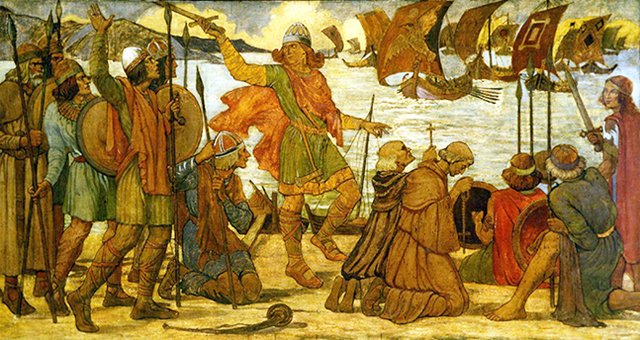Vikings have captured imaginations for centuries. Irish monks trembled at their sight, Early Russians fought them for Baltic water rights, and Byzantine Emperors hired their descendants as bodyguards.
While much has been written about them from various contemporary and more recent sources, the Vikings themselves left few records. As a result, most of what is known of them comes from foreign sources, some with dubious credibility. However, their gravesites, as is so often the case in history, provide a great deal of information.
One matter that such a source cannot help explain is the accuracy of Viking tattoos. They have been described in sources, but no physical evidence has been found as no Viking bodies have survived with their skin intact.
To complicate matters, records from this era are sparse, thanks to the remoteness of various centers of learning, difficulty in travel, and the limited role of urban centers. Also, over the centuries, documents have been lost or destroyed due to time, war, and nature. Still, some sources remain, and they paint an interesting picture.

The Writing of Iban Fadlan on Viking Tattoos
Perhaps the most iconic source regarding Vikings is the travel logs of Iban Fadlan, an Arabian diplomat present in the lands of future Russia during the 10th century.
His extensive writings form the basis of a large part of the historiography of Viking history, at least in earlier times. Despite this, Fadlan never set foot in Scandinavia.
Instead, he was in Volga, and his accounts are based on Vikings in area. As well as being raiders, Vikings also explored and traded nearly as avidly as they assaulted the cities of Medieval Europe.
Still, Fadlan’s text is one of the earliest sources related to Vikings. Within that text, he describes what many consider evidence of tattoos.
In his own words, he wrote, “Never have I seen people with a more perfect body than them. They are tall like palm trees, with blond hair and ruddy skin. From fingertips to their neck, each of them has a collection of trees, figures, and the like.”
Some have pointed to this line as evidence of tattoos. The description, however, is rather vague. It could also describe body paint, or perhaps a highly flowery description of their physique.
Within the Baltic region, tattoos overall were not unknown. The art of placing lasting designs of variously intricate natures onto human skin has existed in many cultures across millennia. Ancient Egyptian mummies have proof of such work, and the art was well-known among various tropical cultures around the world.
In the neighboring region of Denmark, tattoo needles dating to the Bronze Age make for potential evidence that other nearby cultures also practiced the art.
Returning to the preeminent source on early Vikings, Fadlan noted that the ink or paint color appeared as dark green. However, given the materials of the time and the people involved, dark blue ink would be much more likely.
Whether the result of color blindness, poor lighting, or rough translation, blue ink makes more sense. This is because of the use of wood ash to make blue inks, like woad. That presumes, of course, that Fadlan was mistaken on the color.
Additional Potential Sightings of Viking Tattoos
There are other sources on the subject, to an extent. For example, another Arabian merchant named al-Tartushi, traveling from Spain also noted images that might be considered tattoos.
However, as noted here, “The Arabic word used in the original text for “tattoo” was more commonly used to describe mosque decorations rather than actual tattoos— a fitting description considering similarities between a mosque’s geometric patterns and those of a runic Viking tattoos. Also, tattoos are not mentioned in any of the sagas or poetry, although these literary works describe many other physical characteristics such as scars or hair color.”
The evidence is sparse and not entirely convincing, so without concrete, physical evidence, or a more direct descriptive source, the question is unfortunately unanswerable. However, that has not stopped people from speculating and copying what they believe to be impressive, intricate tattoos that the Vikings might have used.
As previously noted, tattoos have a long history across multiple cultures. They also serve various purposes, both for the living and, in some cultures, in the afterlife. As mentioned before, tattoos were common in neighboring regions to the Vikings, so they learned the art from neighbors or developed it independently.
As for modern interpretations, as noted here, “Many tattoo artists have designed Viking tattoos, which can be easily found in many places online. Popular Viking tattoos include the compass tattoo, called the Vegvisir. This symbol is not from the Viking Age, however; it dates to the 17th century, from an Icelandic book on magic. Another popular Viking design for a tattoo is the Helm of Awe or aegishjalmur. This symbol allows the wearer to strike his enemies with fear and confusion. It is also thought to grant magical powers to its wearer.”
Though possible, most of the designs adapted by fans of such artwork, as noted in the previously cited source, are not always accurate to the era or people. As indicated by the sources of the time, the depictions of wildlife and nature would make more sense.
As for why the Vikings would obtain tattoos, the most straightforward answer is that they were avid fans of looking pretty. Vikings were noted for their excellent hygiene, the legacy of which includes saunas.
In addition, they maintained their hair, and wore eyeliner and other forms of makeup, according to Al-tartushi, the Vikings wore seemingly permanent eye makeup around their eyes that enhanced their good looks and gave them a youthful appearance and weren’t above making their weapons or armor look nice.
While religious motives are possible, the simple answer may very well be that Vikings got tattoos because they were cool.
No Clear Answer on Viking Tattoos
Short of more concrete evidence revealing itself, either as newly discovered documentation or a body with preserved skin, it is impossible to say for certain whether or not the Vikings bore tattoos.
Other cultures of the time and region seemed to have the tools to do so, but what little evidence exists is not conclusive. All that said, if the Vikings could obtain tattoos, they would probably do so. Never one to ignore a chance to look pretty, the concept of intricate artwork on their skin would no doubt appeal greatly to Viking peoples.


I’m of Norse decent, and I think that’s a stretch. Most modern , I m mean in the past 10 years or so seem highly unlikely. We are tall people like trees, but tattoos I’d say that some trying hard to find something that just isn’t there.